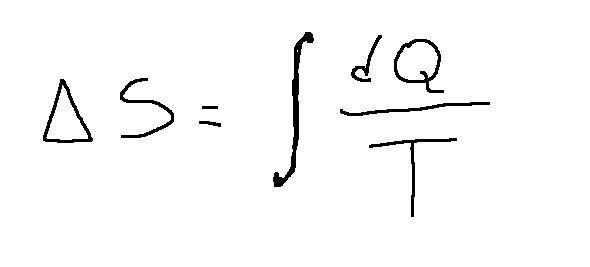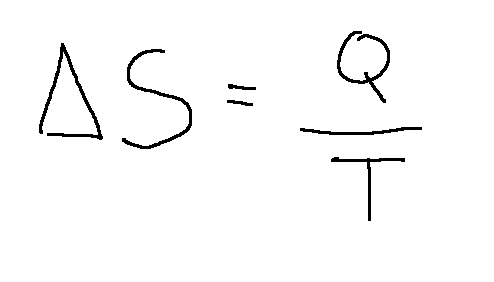04-01-2024 - Physics - Entropy and thermodynamic transformations [EN]-[IT]
hive-163521·@stefano.massari·
0.000 HBD04-01-2024 - Physics - Entropy and thermodynamic transformations [EN]-[IT]
 --- *~~~ La versione in italiano inizia subito dopo la versione in inglese ~~~* --- **ENGLISH** 04-01-2024 - Physics - Entropy and thermodynamic transformations [EN]-[IT] ***Entropy and thermodynamic transformations*** **Entropy** Entropy is a physical quantity that is mainly used in thermodynamic studies. It can be associated with the measure of disorder that is present in a physical system. In the international system it is represented with the letter S and is measured in joules divided by kelvin (J/K) We can add that entropy is a state function of a system in thermodynamic equilibrium. The German physicist Rudolf Clausius was one of the founders of thermodynamic studies and was one of the first to study entropy. With the temperature being a function of the heat in the transformation process between states A and B we can write the following expression with integral.  The situation is simplified if the temperature is constant independent of the heat exchange during the transformation. So we can derive the following best-known and simplified formula.  **Entropy postulate** In an isolated system the entropy S does not decrease, but during an irreversible process, it increases. **Notes on transformations** Entropy studies are done in detail depending on the types of transformation. Below we see some types of thermodynamic transformations: *Isochoric transformation* Thermodynamic transformation at constant volume. In this particular transformation the only state variables that can change are pressure and temperature. *Isobaric transformation* Thermodynamic transformation at constant pressure. *Isothermal transformation* Thermodynamic transformation at constant temperature. *Adiabatic transformation* Thermodynamic transformation in which no heat exchanges occur between the system and the external environment. In the construction field, adiabatic walls are studied. They are thermally insulated walls that do not allow heat exchange. **Conclusions** Entropy is a physical quantity that measures the disorder of a system. This physical quantity was identified together with the first thermodynamic studies carried out in 1800 **Request** Do you remember studying this particular state function? --- https://images.hive.blog/1536x0/https://files.peakd.com/file/peakd-hive/green77/gGQutTRs-hive-spacer.png --- 04-01-2024 - Fisica - Entropia e trasformazioni termodinamiche [EN]-[IT] ***Entropia e trasformazioni termodinamiche*** **Entropia** L'entropia è una grandezza fisica che viene soprattutto usata negli studi termodinamici. Essa può essere associata alla misura del disordine che è presente in un sistema fisico. Nel sistema internazionale viene rappresentata con la lettera S e si misura in joule fratto kelvin (J/K) Possiamo aggiungere che l'entropia è una funzione di stato di un sistema in equilibrio termodinamico. Il fisico tedesco Rudolf Clausius fu uno dei fondatori degli studi termodinamici ed fu uno dei primi a studiare l'entropia. Con la temperatura che è funzione del calore nel processo di trasformazione tra gli stati A e B possiamo scrivere la seguente espressione con integrale.  La situazione si semplifica se la temperatura è costante indipendente dallo scambio di calore nel corso della trasformazione. Quindi possiamo ricavare la seguente formula più nota e semplificata.  **Postulato dell'entropia** In un sistema isolato l'entropia S non diminuisce, ma durante un processo irreversibile, aumenta. **Cenni sulle trasformazioni** Gli studi sull'entropia vengono fatti in maniera dettagliata a seconda delle tipologie di trasformazione. Qui di seguito vediamo alcuni tipi di trasformazioni termodinamiche: *Trasformazione isocora* Trasformazione termodinamica a volume costante. In questa particolare trasformazione le uniche variabili di stato che possono cambiare sono la pressione e la temperatura. *Trasformazione isobara* Trasformazione termodinamica a pressione costante. *Trasformazione isoterma* Trasformazione termodinamica a temperatura costante. *Trasformazione adiabatica* Trasformazione termodinamica in cui non avvengono scambi di calore tra il sistema e l'ambiente esterno. Nel campo dell'edilizia vengono studiate le pareti adiabatiche. Sono pareti termicamente isolate che non permettono scambi di calore. **Conclusioni** L'entropia è una grandezza fisica che misura il disordine di un sistema. Questa grandezza fisica fu individuata insieme a primi studi termodinamici effettuati nel 1800 **Domanda** Vi ricordate di aver studiato questa particolare funzione di stato? **THE END**
👍 ctptips, dexpartacus, vimukthi, pab.ink, healthymary, hardrockcrypto, samubit, marianaemilia, funnel, gabrielrr17, bastter, hkinuvaime, teteuzinho, prosocialise, genepoolcardlord, pedrocanella, hive-world, carlosro, brucolac, vitoragnelli, scrubs24, reppilc, elfino28, carl05, anjanida, mightyrocklee, bteim, dudeontheweb, heruvim1978, garlet, giemo, spurisna, sportgamer, axel-blaze, meppij, nftfrappe, libertycrypto27, cryptomonica, libertypal27, ilcontabile, sweetunicorn, libertypob27, clifth, bananzell, kork75, libertyctp27, pensieristupendi, libertyleo27, blumela, grapthar, stea90, lorenzopistolesi, caleb-marvel, flquin, treefrognada, kaminchan, hive-129556, miingjazz, amestyj, rafzat, lupega, hive-144388, enforcer48, admiralbot, steemseph, nftspecialists, aninsidejob, steemflagrewards, calatorulmiop, memehub, waivio.welcome,